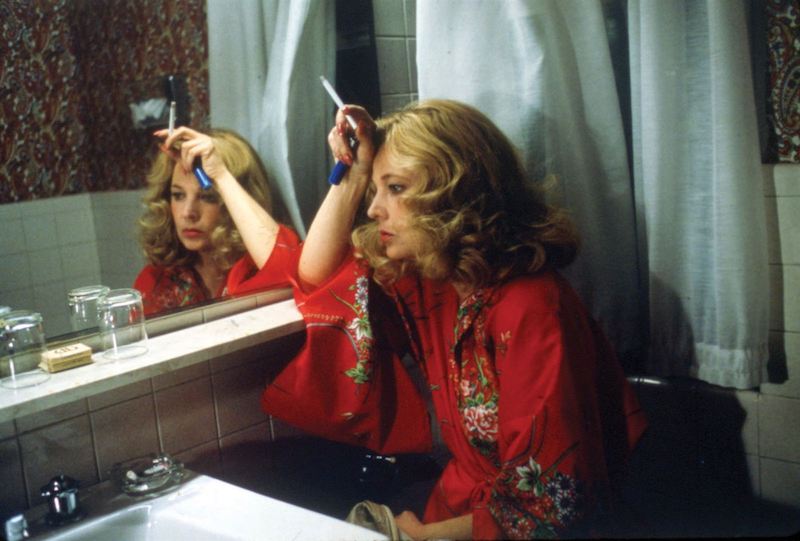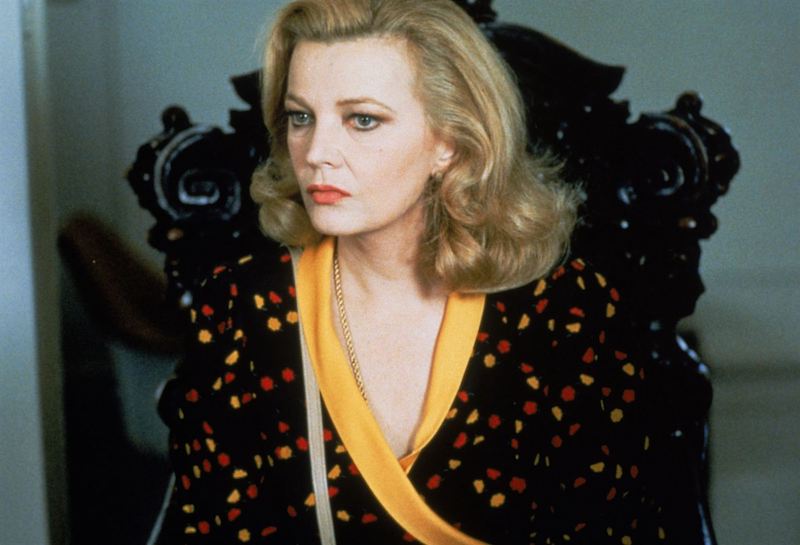“If you were shipwrecked on a desert island, where it was nevertheless possible to project films, which ones would you take? »
Gena Rowlands: “I don’t think I would take A woman under the influence ; it is so upsetting. And Love Streams would sadden me too much: it was the last film that John and I made together. I will probably take Gloria ; it’s a film that would make me feel strong. He would help me survive. »
Gena Rowlands, Mable, Myrtle, Gloria… and the others, Stig Björkman, Editions Cahiers du Cinéma
HASu sound of the complaints of a sax on a background of strings seventies, the eye of John Cassavetes’ camera hovers over New York City at night, floats between illuminated skyscrapers, skirts the Statue of Liberty whose torch, it seems, calls to the poor and exhausted. The eye glides over the water, discovers Manhattan at dawn. A Manhattan of 1980, post-Vietnam War with its twin towers still. The melody hardens. The day is up. The anthill of men bustles in the city with shades of gray. Like the subjective gaze of the angels of The Wings of Desire by Wim Wenders or the flight of bells in the sky of Breaking the Waves by Lars von Trier, John Cassavetes seems to appeal to the divine when he presents with the distance of the bird’s flight the theater of his plot: the Big Apple, twenty centuries after Eden.
It is there that a drama worthy of ancient times will be played out. The camera warns us. Twice during the opening of Gloria, she testifies to the effervescence of Yankee Stadium. Loud arena, present in the background during the massacre of the Dawn family by Mafia representatives. Of this slaughter, only Phil, aged 6, survives. Before dying, his father, an accountant for the criminal organization and a snitch for the FBI, gives his son a compromising book. A poisoned will that he compares to the Bible while shouting at the child this misanthropic commandment: “Be a man. Be tough. Trust no one! “.
The mother, bewildered in her panther blouse, short-circuits the sterility of patriarchal discourse. With the self-preservation instinct of a hunted beast, she entrusts her child to Gloria, a neighbor who has come to ask for coffee. Before perishing under the bullets, she gives life to her son a second time. Better still, she bequeaths to him, via Gloria’s courage and abnegation, the double power of memory. The strength of habit memory and the sensitivity of recollection memory, vital components in the development of any human being. Habitual memory, characterized in the film by the resistance of the bodies of Phil and Gloria, by the unalterable vitality they show in the urban jungle, is also called primitive memory. It is entirely devoted to the attention of life and survival. An unconscious bend taken by the body, it responds to the immediacy of a situation thanks to a subtle network of actions and reactions. Like this sequence where Gloria and Phil are seated, face to face, in a snack. Phil says, “Everything is going wrong! “. He plays the man, calls Gloria a badass, the threat of a possible separation. The woman rebels. Tone up. Suddenly, Gloria grabbed the book from the child’s hands. She gets up, and points the barrel of her revolver towards another table where the mafiosi are seated, discreetly during the scene. Gloria brilliantly disarms them. Openly triggers hostilities by calling the whole band of machos “shabby”.
In this long sequence, the staging of John Cassavetes strives to flush out every shudder of violence, to track down each of its manifestations: the rejection of the little boy, Gloria’s annoyance, the irruption of the enemy clique, and even the bad will of the bartender. Strengthened by this escalation of actions and reactions, the filmmaker expands the present moment to the extreme. Within this space-time, he never ceases to question, jostle, intensify the relief of his narration by favoring the emergence and the bursting of habitual memory in a context of acute crisis.
During the last sequence of the film, Phil, faced with an unknown grave in a cemetery, gives free rein to his reminiscence which turns into a hallucination. In her waking dream, Gloria gets out of a black car. She is disguised as a bereaved grandmother. She gauges Phil with her gaze. The amazed child cannot believe seeing her alive. In slow motion, the little boy rushes towards Gloria. They embrace. For the first time, abandon themselves to tenderness, to the fusion of bodies. Phil’s hallucination defies the laws of time as he removes the disguise of Gloria, both grandmother and mother in his perception. The emotion of the last sequence shot accentuated by the soundtrack composed by Bill Conti reaches the spiritual, because it concludes a fight where primitive memory has thwarted all the traps of adversity, triumphed over fatality. Among the tombstones, in the name of all Phil’s dead, the memory of the surviving child can finally spring up in a lyrical and powerful imagination, a tremendously lively momentum.

Gloria has little in common with the Mable ofA woman under the influence or the Myrtle ofopening night. She doesn’t have the ambition to be a good wife like Mable, doesn’t feel the vocation of an actress like Myrtle. Unaffected by maternal desire, she holds off the pangs of neurosis and the ravages of despair in the face of the flight of time. Feet on the ground, Gloria does not float. In her youth, she may have been the Jeannie of Faces or even one of the girls around the gangster Ben Gazzara in Murder of a Chinese bookmaker.
Former chorister and dancer, call-girl on occasion, Gloria flirted with the Mafia, fell in love with one of their own, went to prison for that. Gloria is an eternal, independent “daughter”, a sturdy who has rolled her bump. Now she can roll in gold with a pet cat, a safe in the bank, and prime clothing.
From her first appearance, Gloria, cigarette in mouth, dressed in a trench coat with handbag, pajamas with a pair of high-heeled shoes, looks like an artist not really ready for her debut. In the doorway, she watches without flinching the Dawn family bustling before her like an aviary on edge. The mother sticks a 6-year-old partner, Phil, in her legs. The kid will propel Gloria into the light. Last lap before it sinks into the night.
Gloria the tall, classy girl with sun-kissed hair and Phil the short, dark-haired man with the ape-like face. The score of this tragedy duet is based on the register of comedy often attributed to couples who love each other, but who are opposed by everything. Mafia atavism obliges, Phil plays the guys, the bosses, wants to subdue this “little bitch” imposed by fate. Gloria, in the autumn of her life, knows by heart the weakness and vanity of men from 6 to 77 years old. She sees the brat coming from afar, tells him that she’s 30 kilos heavier by throwing him out of bed. Phil is knocked out in the first round. With a sly eyebrow and his head buried in his shoulders, he goes back to sleep next to Gloria, who doesn’t care. She turned her back on him in her scarlet kimono.

Like Hubert de Givenchy for Audrey Hepburn in Diamonds on couch by Blake Edwards and Charade by Stanley Donen, Pierre Cardin for Jeanne Moreau in The Bay of Angels by Jacques Demy and Eva by Joseph Losey, Yves Saint Laurent for Catherine Deneuve in beautiful day by Luis Buñuel and The Mississippi Mermaid by François Truffaut, Emmanuel Ungaro creates the costumes for Gena Rowlands in Gloria. In these works of cinema where the actress is queen, the art of a great couturier reveals the psychology of the female role.
To go to war against the Mafia, Gloria wears a gray satin suit and a red silk blouse. Around his neck, a gold pendant watch. The metallic gray of the satin is reminiscent of the flamboyance of the armor of the warrior saints. The red of the blouse, color of anger and passion, refers to the blood that will flow until the fatal outcome. As for the jewel, it indicates that Gloria’s days are numbered.
In the first cemetery sequence, Phil prays for his loved ones in front of an unknown grave. Gloria is wearing the same suit, but in black satin. It’s decided. She no longer hesitates to help the child. She will do anything to save his life, even if a single woman cannot fight the entire Mafia. Among the graves, funeral and premonitory decor, Gloria is in mourning for herself. From then on, the red and the black will not cease to wrap the body of Gena Rowlands.
 Gloria’s latest outfit consists of a silk dress. On the black fabric, a shower of small red and yellow flowers. Shroud adorned with a funeral wreath in the colors of blood and light. The yellow of the collar and the belt matches the blonde halo of the heroine’s hair. Adorned with the color of inner freedom and spirituality, Gloria enters the kingdom of heaven through the front door. She sanctifies by her sacrifice the lonely children of a corrupt, ruthless America. Freewheeling country as symbolized so well by the print on Phil’s shirt in the colors of the Yankee flag. In Gloria (title tribute to Gloria Swanson, the great silent star, heroine of Sunset Blvd. by Billy Wilder), John Cassavetes deconstructs the dream peddled by Hollywood and its studios. He moved his cinema to the East, to New York City. There, he recreates the twilight boulevard on which the actors are no longer fantasies pinned down in Technicolor, but ordinary beings of flesh and blood caught on the spot by a handheld camera.
Gloria’s latest outfit consists of a silk dress. On the black fabric, a shower of small red and yellow flowers. Shroud adorned with a funeral wreath in the colors of blood and light. The yellow of the collar and the belt matches the blonde halo of the heroine’s hair. Adorned with the color of inner freedom and spirituality, Gloria enters the kingdom of heaven through the front door. She sanctifies by her sacrifice the lonely children of a corrupt, ruthless America. Freewheeling country as symbolized so well by the print on Phil’s shirt in the colors of the Yankee flag. In Gloria (title tribute to Gloria Swanson, the great silent star, heroine of Sunset Blvd. by Billy Wilder), John Cassavetes deconstructs the dream peddled by Hollywood and its studios. He moved his cinema to the East, to New York City. There, he recreates the twilight boulevard on which the actors are no longer fantasies pinned down in Technicolor, but ordinary beings of flesh and blood caught on the spot by a handheld camera.
Gloria by John Cassavetes, 1980, 1h56, with Gena Rowlands, Buck Henry, John Adames, Julie Carmen. Blu-ray DVD combo, collector’s edition, Wilde Side Video, 2022.

